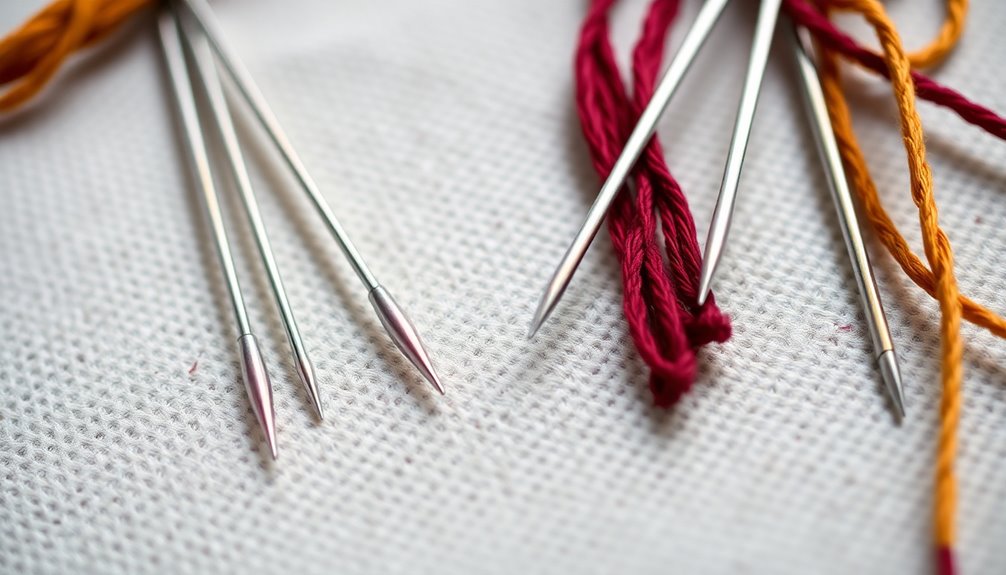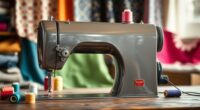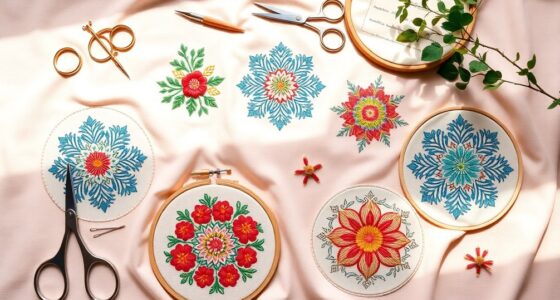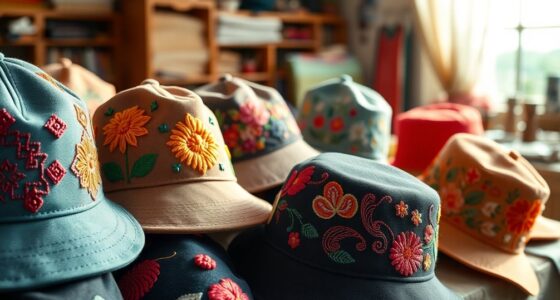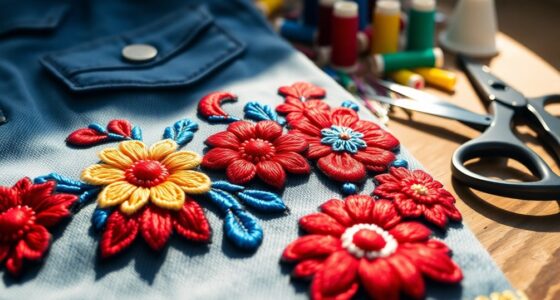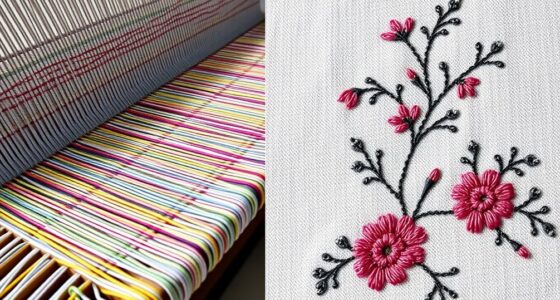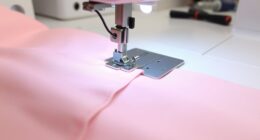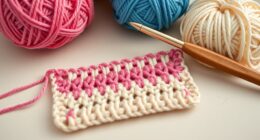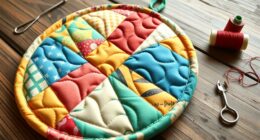Yes, embroidery needles are different from sewing needles. They feature a larger eye and sharper tip, designed to handle thicker threads without shredding. The unique scarf design enhances thread flow, which is essential for achieving high-quality embroidery. Also, various types cater to specific techniques and fabrics, ensuring your projects succeed. If you're curious about which needle to choose or how to maintain them, there's more valuable information ahead!
Key Takeaways
- Embroidery needles have a larger eye than sewing needles to accommodate thicker threads and minimize breakage.
- They feature a sharper tip for enhanced effectiveness on various fabrics.
- A unique scarf design in embroidery needles improves thread flow and reduces breakage compared to standard sewing needles.
- Different types of embroidery needles cater to specific techniques and fabric types, unlike general sewing needles.
- Selecting the appropriate needle type is essential for achieving quality results in embroidery projects.
Understanding Embroidery Needles

When you're diving into the world of embroidery, understanding the unique features of embroidery needles is essential for achieving the best results.
Embroidery needles, also known as crewel needles, have a larger eye than standard sewing needles. This design accommodates thicker threads and minimizes the risk of breakage. The eye bulges out above the shaft, which allows for smoother threading and better compatibility with various techniques.
You'll also find specialty needles, like tapestry and chenille, specifically designed for different fabric types and stitching methods. Each needle size serves a distinct purpose, enhancing the quality of your stitchwork.
Selecting the right embroidery needles based on your project can greatly improve your overall outcome and satisfaction with your work.
Key Differences Between Embroidery and Sewing Needles

Although both embroidery and sewing needles serve the purpose of stitching fabric, their distinct designs cater to different techniques and materials. Here are the key differences: Embroidery needles are specifically designed with a larger eye to accommodate thicker threads, allowing for intricate designs and decorative stitches. In contrast, sewing needles come in various sizes and shapes, each tailored for specific sewing tasks, with finer needles ideal for lightweight fabrics. Understanding the difference between weaving and embroidery is essential for anyone looking to master textile arts, as each technique requires unique tools and approaches for optimal results.
- Eye Size: Embroidery needles have a larger eye compared to sewing needles, preventing shredding and breaking of heavier embroidery threads.
- Tip Sharpness: Embroidery needles feature a sharper tip than standard sewing needles, making them more effective for various embroidery techniques.
- Scarf Design: The unique scarf design of embroidery needles enhances thread flow and reduces breakage, improving overall stitch quality.
Choosing the correct needle type is vital for your projects.
Using embroidery needles over sewing needles guarantees better performance with thicker threads, leading to more successful and visually appealing results.
Anatomy of Embroidery Needles
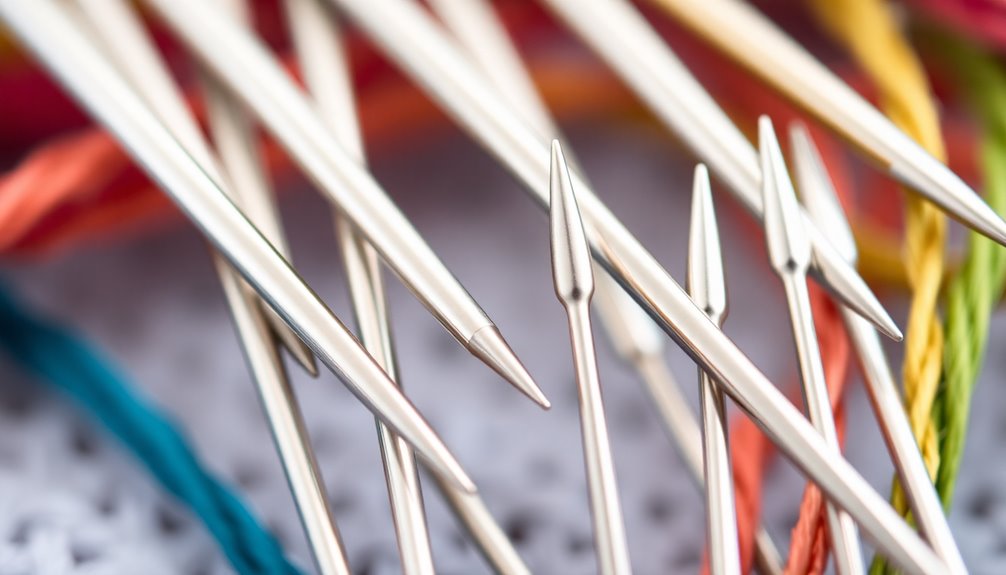
Understanding the anatomy of embroidery needles is crucial for any embroidery enthusiast. These needles consist of six main parts: the shank, blade, groove, eye, scarf, and point, each playing an important role in your projects.
The shank, typically flat on one side, guarantees a snug fit in your sewing machine. The blade extends down to the point, guiding the needle through fabric.
The eye is larger than that of standard sewing needles, allowing thicker embroidery threads and minimizing breakage. The groove channels the thread smoothly to the eye, reducing friction and enhancing stitch quality.
Finally, the uniquely shaped scarf improves thread pickup by the bobbin, guaranteeing consistent stitching throughout your embroidery work.
Types of Embroidery Needles
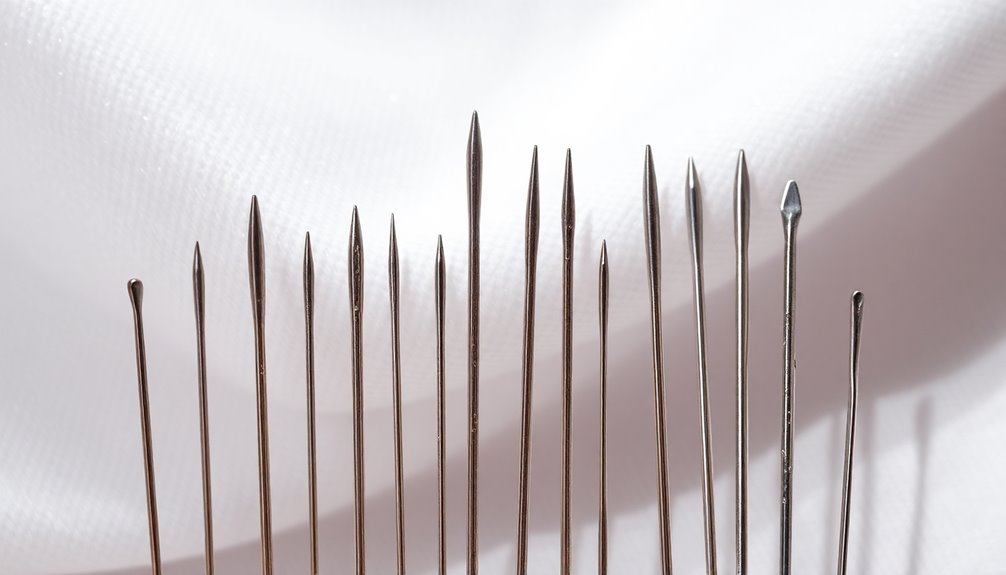
While you may think all embroidery needles are the same, there's a variety of types designed for specific techniques and materials. Understanding these can greatly enhance your stitching experience:
- Crewel Needles: These standard embroidery needles have a sharp tip and a bulging eye, making them versatile for different embroidery techniques.
- Tapestry Needles: Featuring a blunt tip and long eye, they're perfect for counted thread work and needlepoint, protecting your fabric.
- Chenille Needles: With a sharp point and larger eye, these needles handle specialty threads like metallic or thicker embroidery threads with ease.
Additionally, milliner needles are great for precise stitches in fine fabrics, while specialty needles cater to specific materials like ribbon.
Choose the right needle for your project to achieve the best results!
Selecting the Right Needle for Your Project
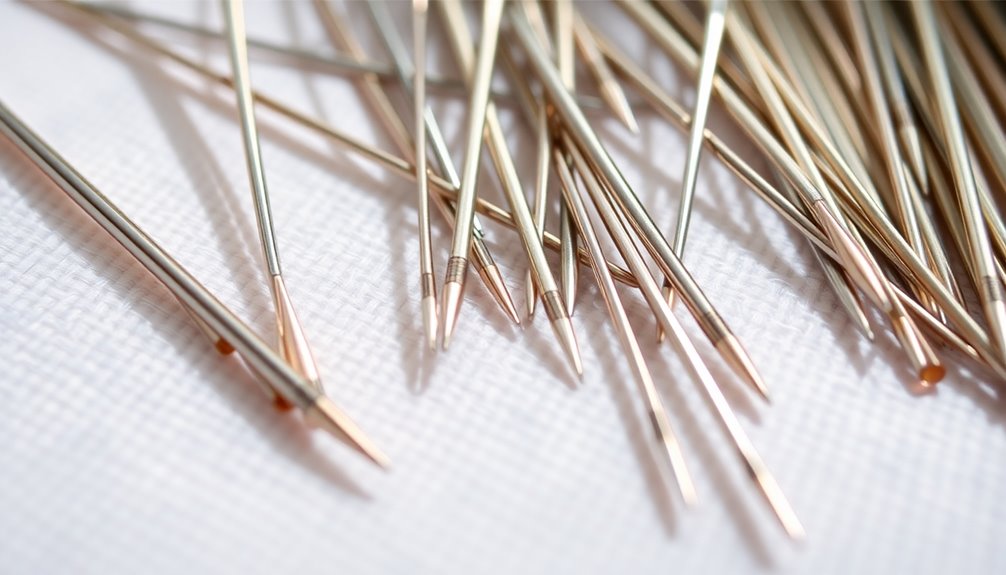
How do you choose the right needle for your embroidery project? Start by selecting embroidery needles, which feature a larger eye to accommodate thicker threads without damage.
Consider the fabric type; for tightly-woven materials, sharp needles work best, while ballpoint needles are ideal for knits.
Match needle sizes to your fabric weight—smaller needles like 75/11 suit lightweight fabrics, and larger ones like 90/14 are perfect for heavier materials.
It's smart to test different types of needles on your fabric to find the best fit for your stitching technique.
Keep a selection of needle sizes and types handy, possibly in variety packs, so you can adapt to various projects and guarantee the best results every time.
Importance of Needle Size
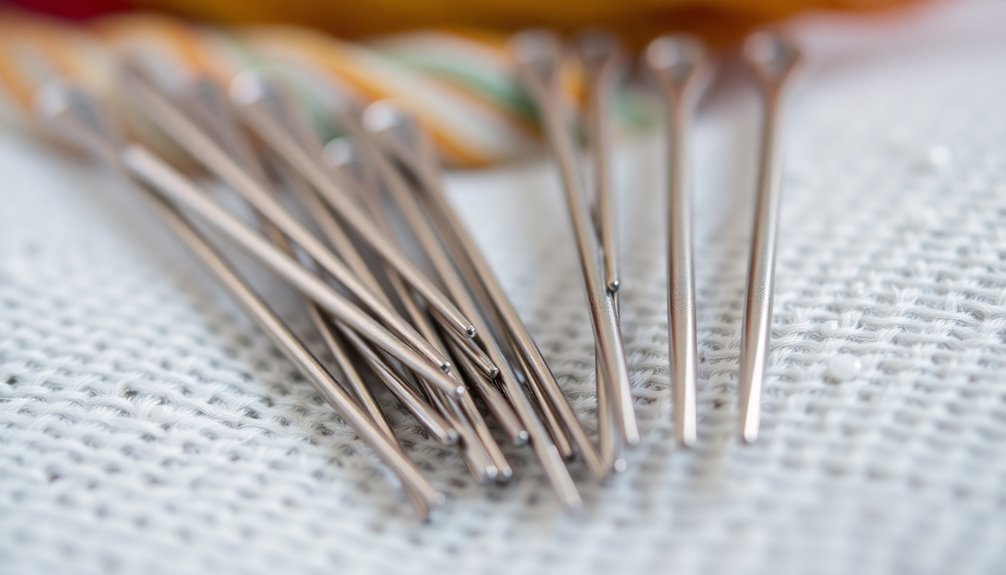
Choosing the right needle size is essential for achieving ideal results in your embroidery projects. The needle size directly impacts your fabric and thread performance, so here's what you need to evaluate:
- Fabric Type: Use smaller sizes (like 75/11) for lightweight fabrics and larger sizes (like 90/14) for heavier materials.
- Thread Tension: The right needle size helps maintain proper thread tension, ensuring even stitch formation.
- Testing: Always test different needle sizes on fabric before starting. This helps you find the best needle to use for your specific embroidery technique.
Specialty Needles for Specific Techniques
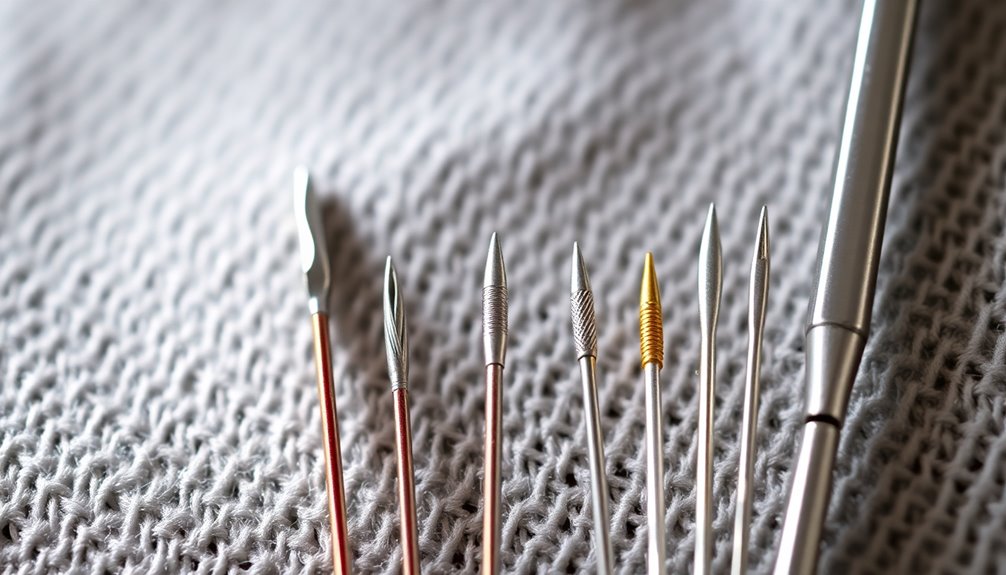
When you explore specialty embroidery techniques, using the right needle is essential for achieving the best results. Specialty embroidery needles are designed for specific tasks.
For instance, a chenille needle features a larger eye and thick shaft, making it perfect for metallic threads without shredding. If you're working on precise stitching techniques like drizzle stitches, Milliner needles, with their long, slender shafts and small round eyes, are ideal.
For counted thread work, tapestry needles have blunt tips and larger eyes to glide between fabric threads easily. Huck needles, with rounded tips, facilitate smooth handling for huck embroidery.
Finally, ribbon needles are uniquely shaped to accommodate ribbon, ensuring a seamless stitching experience without damaging the material.
Maintenance and Care of Needles
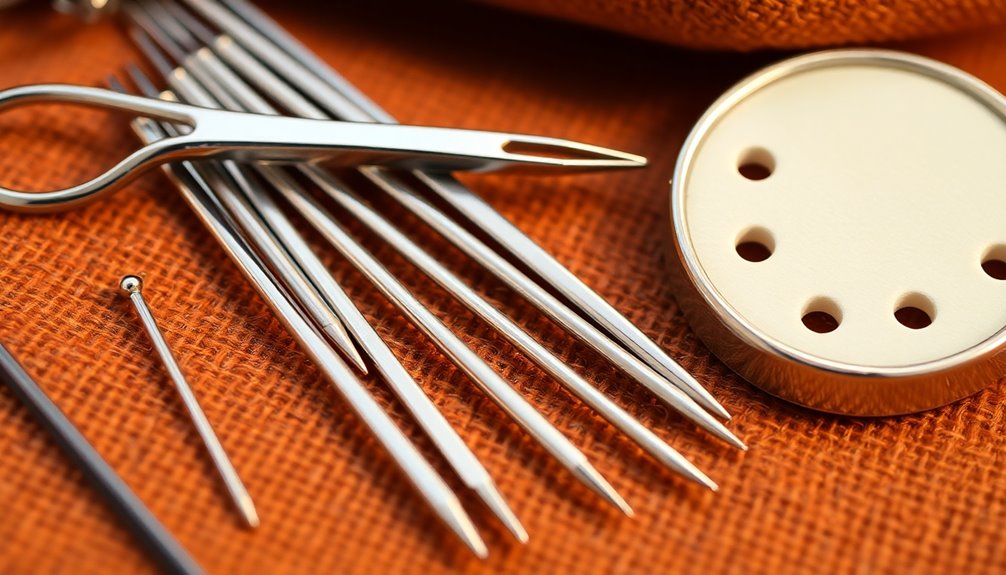
Taking care of your needles is essential for achieving the best results in your embroidery projects.
Make sure to replace them every eight hours and store them properly to avoid damage or loss.
Needle Replacement Schedule
Maintaining your embroidery needles is essential for achieving the best results in your projects. A proper needle replacement schedule can make all the difference.
Here are some key points to take into account:
- Change your embroidery needles every eight hours of use to prevent thread breaks and guarantee top stitching quality.
- Inspect your needles regularly for burrs or damage. Even minor imperfections can affect performance, so don't ignore them.
- Keep a variety of needle types and sizes on hand. This allows you to experiment and assures you have the right needle for different projects.
Proper Storage Techniques
Properly storing your needles is essential for extending their lifespan and ensuring they perform at their best. To keep needles on hand, always store needles in a dedicated container or needle case. This prevents loss and protects them from bending or dulling.
Organize needles by type and size for easy access during your embroidery projects. Remember to avoid exposing needles to humidity or extreme temperatures, as this can lead to rusting and decreased performance.
Regularly inspect needles for signs of wear, like dullness or burrs, and replace them when necessary. Finally, keep your needles away from direct sunlight and sharp objects to prevent accidental injury and prolong their lifespan.
This way, you'll always have reliable tools ready for your next project.
Testing Needles for Optimal Performance
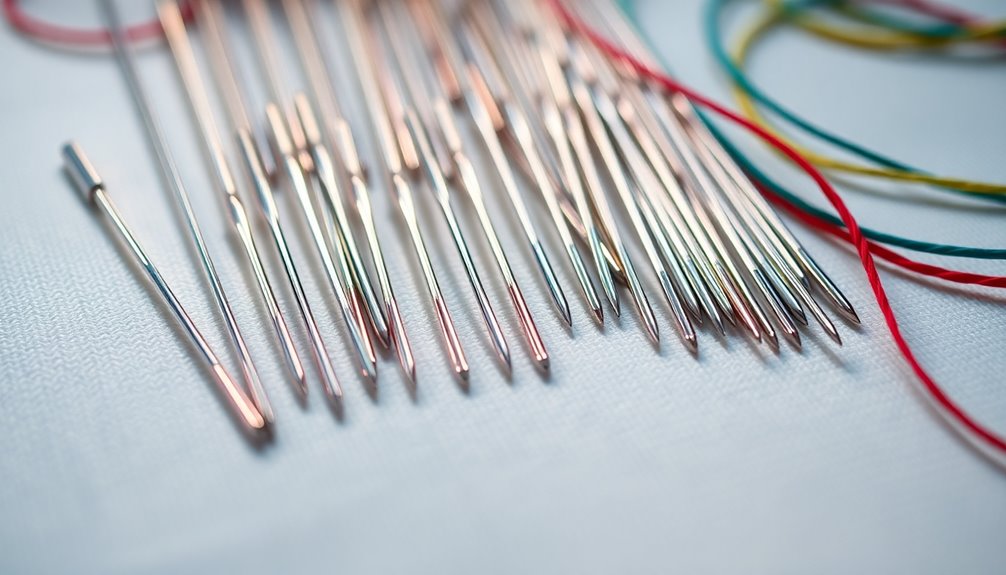
Before starting your project, it's essential to test different needle types on fabric scraps to find the best match for your thread and fabric.
Pay attention to how each needle performs, as this can influence stitch quality and prevent issues like thread breakage.
Keeping a variety of needles handy allows you to experiment and discover what works best for your unique style and materials.
Needle Compatibility Testing
When you're starting a sewing project, testing needle compatibility is essential for achieving the best performance.
Understanding how different needle types interact with your fabric and thread can prevent issues like thread breakage and guarantee an even stitch quality.
Here's how to effectively conduct needle compatibility testing:
- Select a range of needle types (embroidery needles, universal, ballpoint) and sizes.
- Experiment on a swatch of your intended fabric, observing the stitch appearance and fabric response.
- Document which needle types and sizes yield the best results for specific threads.
Fabric and Thread Considerations
Testing needle compatibility lays the groundwork for understanding how fabric and thread choices impact your sewing projects.
When choosing an embroidery needle, consider the fabric type and weight. Heavier fabrics typically require larger needles, like 80/12 or 90/14, while lighter fabrics benefit from smaller sizes, such as 60/8 or 75/11.
Testing different needle types—sharp, ballpoint, or universal—on fabric scraps helps you determine the best fit for your chosen embroidery thread. The needle's eye size should match the thread thickness; larger eyes are vital for heavier threads to avoid shredding.
Regularly changing needles is important, as a dull needle can negatively affect thread tension and stitch quality, leading to project dissatisfaction.
Quality Brands and Where to Buy

Choosing the right needles can make all the difference in your embroidery projects, and several quality brands stand out for their reliability and performance.
Here are some top choices to evaluate:
- Bohin – Renowned for their durability and precision.
- Richard Hemming & Sons – Offers a wide range of needle types for all your needle needs.
- John James – Well-known for their quality hand embroidery needles.
You can find these quality needle brands at local craft stores, where you can feel and compare options.
For more variety, check out online stores like Needle in a Haystack and Hedgehog Handworks, which specialize in embroidery threads and notions.
Don't forget to visit Mary Corbet's Needle n Thread for expert reviews and tips!
Frequently Asked Questions
Can I Use Embroidery Needles for Sewing?
Yes, you can use embroidery needles for sewing, but it's not always the best choice.
They're designed for thicker threads and mightn't perform well on tightly woven fabrics. You might notice issues with thread tension and stitch quality, especially when working with lightweight materials.
For most general sewing tasks, it's better to stick with standard sewing needles, as they penetrate fabric more efficiently and provide cleaner results.
What Is the Difference Between a Sewing Needle and an Embroidery Needle?
When you compare sewing needles and embroidery needles, you'll notice key differences.
Embroidery needles have a larger eye to accommodate thicker threads, preventing breakage. Their unique scarf design enhances thread flow, while sewing needles typically feature sharper tips for basic tasks.
If you're working on intricate embroidery, using the right needle is essential; it'll guarantee better stitch quality and reduce the risk of fraying or shredding your threads.
Choose wisely for your projects!
Do You Use the Same Thread for Sewing and Embroidery?
When you're diving into the world of stitching, remember that not all threads are created equal.
You wouldn't wear a tuxedo to a picnic, right? Similarly, sewing and embroidery threads serve different purposes.
Sewing thread is your reliable workhorse for seams, while embroidery thread adds that touch of flair to your designs.
Can I Use a 90-14 Needle for Embroidery?
You can use a 90/14 needle for embroidery, especially on heavier fabrics.
However, it's not the best choice for delicate threads or intricate designs, as it may create larger holes in your fabric.
If you're working with lighter threads, a smaller needle like 75/11 would be better.
Always test the needle on a scrap piece of fabric first to ascertain it works well with your specific embroidery project.
Conclusion
In the world of needlework, choosing the right needle can be as essential as a knight picking the perfect sword for battle. By understanding the unique features of embroidery needles versus sewing needles, you can elevate your projects to new heights. Remember, the right tool makes all the difference, allowing your creativity to shine like Excalibur in the hands of Arthur. So, equip yourself wisely, and let your stitching adventures begin!
